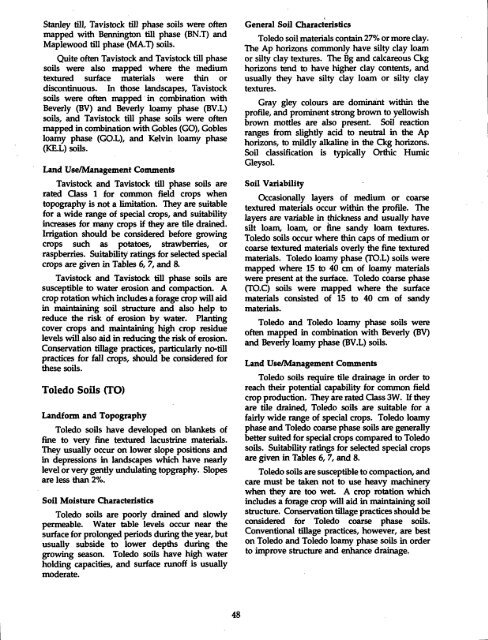The Soils of Elgin County - Agriculture and Agri-Food Canada
The Soils of Elgin County - Agriculture and Agri-Food Canada
The Soils of Elgin County - Agriculture and Agri-Food Canada
- No tags were found...
You also want an ePaper? Increase the reach of your titles
YUMPU automatically turns print PDFs into web optimized ePapers that Google loves.
Stanley till, Tavistock till phase soils were <strong>of</strong>tenmapped with Bennington till phase (BN.T) <strong>and</strong>Maplewood till phase (MA.T) soils .Quite <strong>of</strong>ten Tavistock <strong>and</strong> Tavistock till phasesoils were also mapped where the mediumtextured surface materials were thin ordiscontinuous. In those l<strong>and</strong>scapes, Tavistocksoils were <strong>of</strong>ten mapped in combination withBeverly (BV) <strong>and</strong> Beverly loamy phase (BV.L)soils, <strong>and</strong> Tavistock till phase soils were <strong>of</strong>tenmapped in combination with Gobles (GO), Goblesloamy phase (GOI), <strong>and</strong> Kelvin loamy phase(IE.L) soils .L<strong>and</strong> Use/Management CommentsTavistock <strong>and</strong> Tavistock till phase soils arerated Class 1 for common field crops whentopography is not a limitation . <strong>The</strong>y are suitablefor a wide range <strong>of</strong> special crops, <strong>and</strong> suitabilityincreases for many crops if they are tile drained.Irrigation should be considered before growingcrops such as potatoes, strawberries, orraspberries. Suitability ratings for selected specialcrops are given in Tables 6, 7, <strong>and</strong> 8.Tavistock <strong>and</strong> Tavistock till phase soils aresusceptible to water erosion <strong>and</strong> compaction . Acrop rotation which includes a forage crop will aidin maintaining soil structure <strong>and</strong> also help toreduce the risk <strong>of</strong> erosion by water . Plantingcover crops <strong>and</strong> maintaining high crop residuelevels will also aid in reducing the risk <strong>of</strong> erosion.Conservation tillage practices, particularly no-tillpractices for fall crops, should be considered forthese soils .Toledo <strong>Soils</strong> (TO)L<strong>and</strong>form <strong>and</strong> TopographyToledo soils have developed on blankets <strong>of</strong>fine to very fine textured lacustrine materials .<strong>The</strong>y usually occur on lower slope positions <strong>and</strong>in depressions in l<strong>and</strong>scapes which have nearlylevel or very gently undulating topgraphy . Slopesare less than 2%.Soil Moisture CharacteristicsToledo soils are poorly drained <strong>and</strong> slowlypermeable. Water table levels occur near thesurface for prolonged periods during the year, butusually subside to lower depths during thegrowing season . Toledo soils have high waterholding capacities, <strong>and</strong> surface run<strong>of</strong>f is usuallymoderate.General Soil CharacteristicsToledo soil materials contain 27% or more clay .<strong>The</strong> Ap horizons commonly have silty clay loamor silty clay textures . <strong>The</strong> Bg <strong>and</strong> calcareous Ckghorizons tend to have higher clay contents, <strong>and</strong>usually they have silty clay loam or silty claytextures .Gray gley colours are dominant within thepr<strong>of</strong>ile, <strong>and</strong> prominent strong brown to yellowishbrown mottles are also present. Soil reactionranges from slightly acid to neutral in the Aphorizons, to mildly alkaline in the Ckg horizons .Soil classification is typically Orthic HumicGleysol.Soil VariabilityOccasionally layers <strong>of</strong> medium or coarsetextured materials occur within the pr<strong>of</strong>ile . <strong>The</strong>layers are variable in thickness <strong>and</strong> usually havesilt loam, loam, or kme s<strong>and</strong>y loam textures .Toledo soils occur where thin caps <strong>of</strong> medium orcoarse textured materials overly the fine texturedmaterials . Toledo loamy phase (TOI) soils weremapped where 15 to 40 cm <strong>of</strong> loamy materialswere present at the surface. Toledo coarse phase(TO.C) soils were mapped where the surfacematerials consisted <strong>of</strong> 15 to 40 cm <strong>of</strong> s<strong>and</strong>ymaterials .Toledo <strong>and</strong> Toledo loamy phase soils were<strong>of</strong>ten mapped in combination with Beverly (BV)<strong>and</strong> Beverly loamy phase (BV.L) soils.L<strong>and</strong> Use/Management CommentsToledo soils require the drainage in order toreach their potential capability for common fieldcrop production. <strong>The</strong>y are rated Class3W. If theyare tile drained, Toledo soils are suitable for afairly wide range <strong>of</strong> special crops. Toledo loamyphase <strong>and</strong> Toledo coarse phase soils are generallybetter suited for special crops compared to Toledosoils . Suitability ratings for selected special cropsare given in Tables 6, 7, <strong>and</strong> 8.Toledo soils are susceptible tocompaction, <strong>and</strong>care must be taken not to use heavy machinerywhen they are too wet . A crop rotation whichincludes a forage crop will aid in maintaining soilstructure. Conservation tillage practices should beconsidered for Toledo coarse phase soils .Conventional tillage practices, however, are beston Toledo <strong>and</strong> Toledo loamy phase soils in orderto improve structure <strong>and</strong> enhance drainage .
















